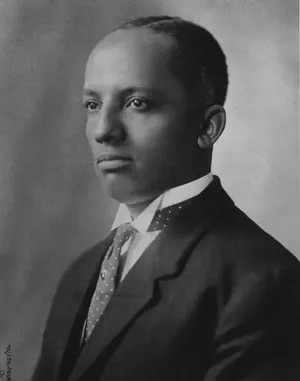'Black History Month is not a token': What to know about nearly 100-year-old tradition
The month-long commemoration created to reflect on the past, acknowledge the continued struggle for racial justice and draw inspiration from the achievements of African Americans begins on Thursday.
Black History Month, a federally recognized celebration, was created nearly a century ago to recognize the “the countless Black men and women who had contributed to the advance of human civilization,” according to the Association for the study of African American Life and History.
It has since become “one of the most celebrated cultural heritage months on the calendar” LaGarrett J. King, an associate professor of social studies education at University at Buffalo told USA TODAY last year.

Schools, businesses and organizations alike have embraced the tradition, offering exhibits, presentations, meals and even games. Some of these practices, though, can come off as insensitive, inaccurate, and inappropriate.
Let your tributes, this month, be “informative and not performative,” April Reign, the woman behind the #OscarsSoWhite movement and consultant on issues of diversity, inclusion and representation shared with USA TODAY previously.
Here’s what you should know about Black History Month, from when it started to ways to commemorate the month accordingly.
Mardi Gras 2024:New Orleans parade schedule, routes, what to know about the celebration
Who made Black History Month?

Carter G. Woodson, known to many as the “Father of Black History” came up with the concept of “Negro History Week” in 1926, intended to “both create and popularize the knowledge about the Black past.”
Woodson, whose parents were enslaved, grew up to be an author, historian and the second African American to earn a Ph.D. at Harvard University.
He formed the Association for the Study of Negro Life and History, now known as the Association for the Study of African American Life and History “to promote the scientific study of Black life and history” in September of 1915, months after he participated in a national celebration of the 50th anniversary of emancipation in Illinois, according to the ASALH website.
Woodson spent the decades leading up to his death working to meet the growing popularity of the celebration he created, giving out pictures, lessons for teachers, plays for historical performances, and posters of important dates and people.
He believed that one day the weekly celebrations would come to an end, looking forward to a time when an “annual celebration would no longer be necessary” because African Americans would have the ability to “learn of their past on a daily basis,” the ASALH website reads.
It wasn't until 1976 that Woodson’s organization was able to “use its influence to institutionalize the shifts from a week to a month and from Negro history to Black history.”
Since President Gerald Ford signed that first proclamation in 1976, every American president has issued proclamations endorsing the theme set forth by the Association for the Study of African American Life and History.
When is Black History Month?
The celebration, which does not have to be confined to a single month, is typically observed Feb. 1 through the end of the month.
“Black History Month is not a token. It is a special tribute—a time of acknowledgement, of reflection, and inspiration—that comes to life in real and ongoing activities throughout the year,” writes Evelyn Brooks Higginbotham, former ASALH National President, pointing to the appearance of Black History across medium.
“The great lives and material culture of Black History” has been seen in museums, literature, national park sites, music and even cemeteries, according to Higginbotham.
Book Bans:Black history 'Underground Railroad' forms across US in response
Why is Black History Month in February?

Woodson chose February because the month coincides with the “birthdays of two great Americans who played a role in shaping Black history,” according to the ASALH website.
Those two great Americans were Frederick Douglass, a famed abolitionist who escaped from slavery and celebrated his birthday Feb. 14, and President Abraham Lincoln, who formally abolished slavery and was born on Feb. 12. Black History Month, initially established as “Negro History Week” was created around days that were already celebrated by Black communities across the country.
“Woodson built Negro History Week around traditional days of commemorating the Black past, asking the public to extend their study of Black history, not to create a new tradition,” the ASALH website reads.
Richard Wright, a civil rights advocate and author, also spent time lobbying for the celebration of a day in February, called National Freedom Day. The day marks the anniversary of the approval of the 13th Amendment, which abolished slavery in 1865, USA TODAY previously reported.
President Harry Truman did recognize National Freedom Day in 1949, urging citizens to contemplate its significance.
Though the day never became a federally recognized holiday, it coincides with the start of Black History Month, which kicks off the first of every February.
What are some ways I can commemorate Black History Month?

The purpose of Black History Month, no matter what form the festivity takes, is to educate and celebrate Black history. This year’s theme for Black History Month, decided annually by the ASALH since 1928, is African Americans and the Arts.
There are a number of ways you can observe the occasion, from attending a luncheon hosted by the ASALH to immersing yourself in online programming offered by the Smithsonian’s National Museum of African American History and Culture.
The museum has also given the public access to a digital toolkit, as a way to “celebrate the Black people who have used art as their platform for social justice.”
Other ways to celebrate Black History Month include checking out reading lists, online resources or multimedia related to this year’s theme. Date and times for in-person gatherings, festivals, or performances will vary by location, so be sure to look for information specific to your city.

Disclaimer: The copyright of this article belongs to the original author. Reposting this article is solely for the purpose of information dissemination and does not constitute any investment advice. If there is any infringement, please contact us immediately. We will make corrections or deletions as necessary. Thank you.






